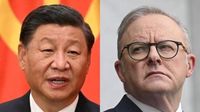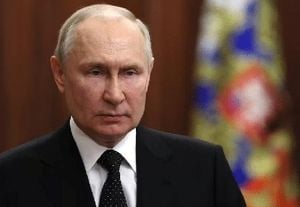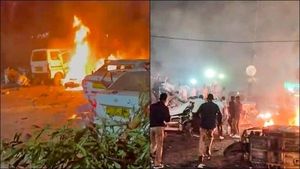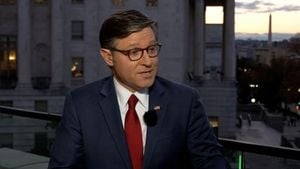Venice’s red carpet shimmered with anticipation on September 2, 2025, as Kathryn Bigelow returned to the world stage with her latest film, A House of Dynamite, premiering at the 82nd Venice International Film Festival. The Oscar-winning director, celebrated for her gripping takes on war and politics in The Hurt Locker and Zero Dark Thirty, has chosen once again to tackle a subject that feels ripped from the world’s most urgent headlines: the ever-present threat of nuclear conflict. But as Bigelow’s fictional White House braced for an imminent nuclear strike, the real world outside the cinema was wrestling with its own rising anxieties about atomic arms—and nowhere more so than in the Indo-Pacific, where Australia finds itself on the frontlines of a new power struggle with China.
Bigelow’s film, set largely within the claustrophobic corridors of the White House, imagines a nightmare scenario: the United States faces an incoming nuclear missile from an unknown adversary. Panic, dread, and impossible decisions unfold in real time as military and civilian leaders scramble to avert catastrophe. Rebecca Ferguson leads as Captain Olivia Walker, a senior White House official tasked with keeping the government afloat, while Idris Elba plays a national security adviser torn between cold strategy and human morality. The ensemble cast—Jared Harris, Tracy Letts, Gabriel Basso, Anthony Ramos, Greta Lee, Moses Ingram, and Jason Clarke—portrays the full spectrum of power and panic as the world teeters on the edge.
At the Venice press conference, Bigelow was clear about her intentions. “We need to be much more informed, and that would be my greatest hope—that we actually initiate a conversation about nuclear weapons and non-proliferation in a more perfect world,” she told The Hollywood Reporter. “The film is an invitation to decide what to do about all these weapons. How is annihilating the world a good defensive measure?” Her words echoed the urgency of the film itself, which is set for worldwide release on Netflix on October 24, 2025.
Screenwriter Noah Oppenheimer, who began writing the script two years ago, explained that the movie’s geopolitical backdrop is less about specific current events and more about the ongoing reality of the nuclear age. “There are now nine countries on earth that have nuclear arsenals that could end human civilization several times over,” Oppenheimer said. “It’s miraculous, frankly, that something horrific hasn’t happened already. So many of these weapons are on a trigger system and, in countries like ours, one individual, the president, has the sole authority to authorize their use.”
Bigelow’s personal history with nuclear anxiety is woven into her filmmaking. “I grew up in an era when hiding under your school desk was considered the go-to protocol for surviving an atomic bomb,” she recalled. “It seems absurd now—and it was—but at the time, the threat felt so immediate that such measures were taken seriously. Today, the danger has only escalated. Multiple nations possess enough nuclear weapons to end civilisation within minutes. And yet, there’s a kind of collective numbness—a quiet normalisation of the unthinkable. How can we call this ‘defense’ when the inevitable outcome is total destruction?”
While Bigelow’s fictional world explores the horror of a nuclear standoff, the real world is hardly immune to the same fears. Just as the film premiered, Australian Minister Pat Conroy issued a stark warning about the growing contest with China in the Indo-Pacific, likening it to the Cold War’s brush with “nuclear armageddon.” Conroy, who oversees both Australia’s defense industry and its Pacific relations, told NewsWire, “Where we talk about the strategic uncertainty, we talk about the biggest arms race since 1945. We’ve got a situation where we’ve got a rise in a great power that’s trying to exert its influence in the region. This is a uniquely challenging circumstance for Australia that we haven’t seen since World War Two.”
China’s ambitions in the Pacific have been relentless, with so-called “debt-trap diplomacy” and military posturing around Taiwan raising the stakes. According to U.S. Defense Secretary Pete Hegseth, speaking at Singapore’s Shangri-La Dialogue in May, the Chinese Communist Party represents a “real” and “imminent” threat to the Indo-Pacific. The People’s Liberation Army has repeatedly violated Taiwan’s air and maritime space, conducted simulated invasions, and, as an Australian government source confirmed, aims to have key military capabilities by 2027—though there’s no guarantee of when or if conflict will erupt.
Australia, meanwhile, is scrambling to shore up its own deterrence. Conroy described a two-pronged strategy: deepening relationships with smaller Pacific neighbors, such as a $600 million National Rugby League team deal with Papua New Guinea, and rapidly expanding military capabilities. “All we can do is equip the Australian Defence Force to increase … its ability to deter conflict and protect our interests, as well as ramping up massively our diplomatic efforts to ensure that we’re the partner of choice in the Pacific,” he explained. But the challenges are formidable. Budget constraints, sluggish global defense production, and the sheer pace of China’s military buildup—its nuclear warhead arsenal has nearly tripled in the past five years, according to U.S. estimates—make it a race against time.
Prime Minister Anthony Albanese’s July visit to China was billed as a diplomatic thaw, with high-level meetings and hopes for peace through economic ties. Yet, the backdrop was anything but tranquil. Chinese warships had recently circumnavigated Australia, conducting live-fire drills that, according to Deputy Prime Minister and Defence Minister Richard Marles, included practicing strikes on Australian cities. “This is the most consequential time geopolitically for Australia since 1945,” Conroy said. “Even at the height of the Cold War, we were on the periphery. So, short of nuclear armageddon, the Cold War was playing out in Europe and through proxy wars in places like Korea. The Pacific is now the frontline of this contest for geopolitical influence, and if we get it wrong, Australia is going to be in a very challenging circumstance.”
Bigelow’s A House of Dynamite and the real-world warnings from Canberra may seem like parallel stories, but they’re really two sides of the same coin. Both are sounding the alarm about a world where the unimaginable—nuclear conflict—has become a shadow lurking just behind the day’s headlines. The film, with its taut drama and urgent questions, is more than entertainment; it’s a call to awareness. As Bigelow put it, “I wanted to make a film that confronts this paradox—to explore the madness of a world that lives under the constant shadow of annihilation, yet rarely speaks of it.”
With nuclear arsenals swelling and geopolitical tensions rising, the conversation Bigelow hopes to spark feels more necessary than ever. Whether in the White House Situation Room or the halls of the Australian Parliament, the question remains: how long can the world live in a house of dynamite before someone lights the fuse?




